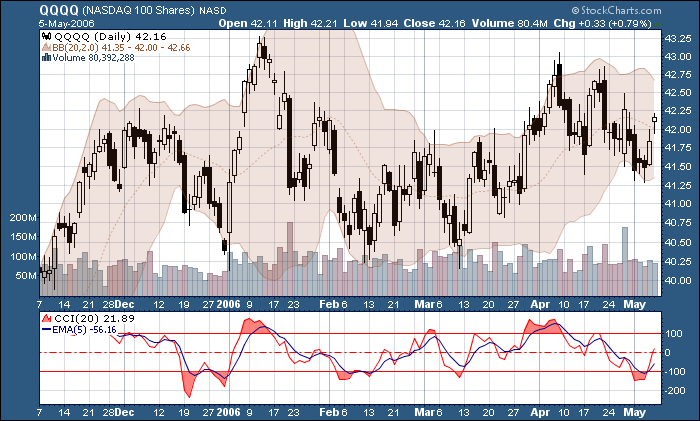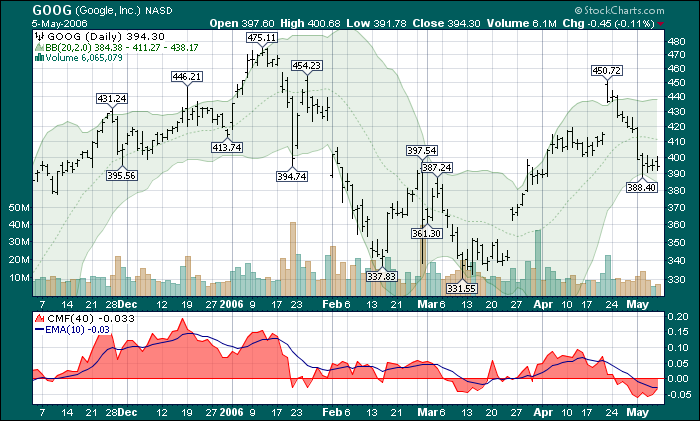SIGNAL LINES GALORE
One of the huge new features of SharpCharts2 is its ability to plot "indicators of indicators." In other words, SharpCharts2 can chart indicators based on the value of another indicator which, in turn, is based on the value of the chart's main stock, index or fund. In our last newsletter, I included an example of how you could use the Slope indicator to see the changes in the MACD more clearly. This time around I want to show you how the same technique can be used to add signal lines to just about anything.
A signal line is a moving average of an indicator that is typically plotted on top of the indicator so that cross-overs are easy to spot. Many indicators such as the MACD and Stochastics indicators are typically plotted with signal lines already. However there are still a large number of indicators that aren't typically plotted with signal lines. Fortunately, with SharpCharts2, StockCharts.com members can easily add signal lines to any indicator they want.
Earlier this week, subscribers to John Murphy's Market Message got a taste of just how powerful this capability can be when guest columnist Jeanette Young used a 5-period EMA signal line on the 20-period CCI indicator.
"The study on the bottom is one which I use, the Commodity Channel Index with a 5- period exponential moving average on top. The reason that this 5- period exponential moving average is placed on the CCI is to obtain better triggers than would be offered by the CCI alone. Were I to use the CCI alone, I would miss about 75% of the trade. By using the 5- period Exponential Moving average, I have created a trigger for both a buy and a sell." - Jeanette Young
Here's an example of Jeanette's technique in action:
(Click on the chart to see the parameter settings.)
To create this chart, first log into your account, then plot a daily chart of the Qs with the Blue-Grey color scheme. Hit the "Clear All" button in the "Indicators" section to remove any other indicators, then add the "CCI" Indicator to the chart and click "Update." Click on the green "Advanced Options" triangle to pull-out those choices (sorry, you have to be a member to use the advanced options), then change the "Color" to red. The "Overlay" dropdown is the key to charting indicators of indicators. Select "Exp. Mov. Avg" from the "Overlay" dropdown, then enter "5" in the "Parameters" box.
That's it! Just click "Update" to see the final result. The 5-period EMA (in blue) crossed the red CCI line two days ago giving a sell signal. Note that these are pretty short-term buy/sell signals - you might want to use longer periods if you are a longer-term investor.
Here's another example using one of my favorite indicators, the Chaiken Money Flow. Long-term ChartWatchers know that I like the CMF because it combines price action with volume action to create one indicator. While longer-term CMF lines aren't super-jittery, adding a signal line to the mix can help you be sure you are seeing the indicator's message clearly.
(Click on the chart to see the parameter settings.)
In this case, I'm using a 40-day CMF combined with a 10-day EMA signal line. Despite the big declines of the last two weeks, this chart suggests things are looking up in the near term for GOOG as the CMF is just about to cross back above the blue signal line.
Signal line work well with indicators that are not too smooth and not too "angley." Signal lines on smoothed oscillators (like the ultimate oscillator) tend to give very few signals and most of those are late. Signal lines on "angley" indicators (like the Aroon) are unable to react quickly enough to the quick direction changes.
Other than those cases, signal lines work great. I encourage you to experiment with them on your charts and see how they can help you make better investing decisions.
- Chip Anderson


